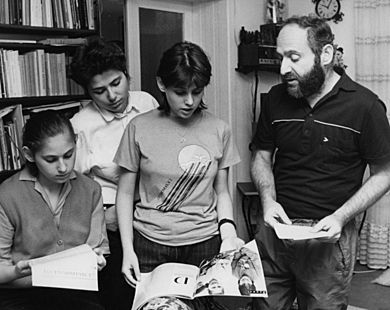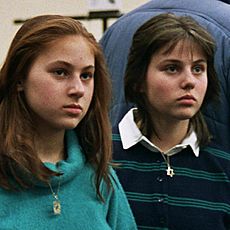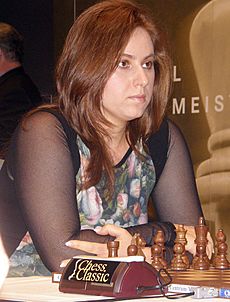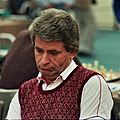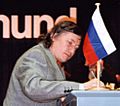Judit Polgár facts for kids
Quick facts for kids Judit Polgár |
|
|---|---|
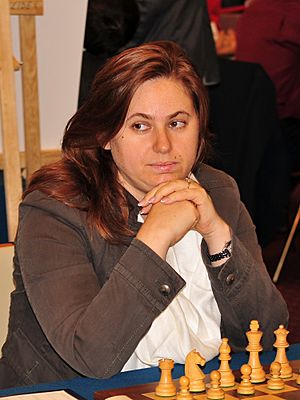
Polgár in 2013 (Warsaw)
|
|
| Country | Hungary |
| Born | 23 July 1976 Budapest, Hungary |
| Title | Grandmaster (1991) |
| FIDE rating | 2675 (December 2025) (inactive since September 2015) |
| Peak rating | 2735 (July 2005) |
| Peak ranking |
|
Judit Polgár (born 23 July 1976) is a Hungarian chess grandmaster. She is known as the best female chess player ever. Judit is the only woman to reach the top 10 chess players in the world. She is also the only woman to get a rating over 2700 points. Judit is the only woman to play in the final part of a World Chess Championship. She was the top-ranked woman chess player from January 1989 until she stopped playing professionally in 2014.
Judit was a super talented chess player from a young age. At 12, she became the youngest player to join the top 100 FIDE rating list. In 1991, she became the youngest player at that time to become a Grandmaster. She was 15 years and 4 months old. This broke the record held by former world champion Bobby Fischer for 33 years.
Polgár won or shared first place in many chess tournaments. These include Hastings 1993, Madrid 1994, and León 1996. She also won the U.S. Open in 1998. Judit is the only woman to have won a game against a reigning world number one player. She defeated eleven current or former world champions. Some of these champions are Magnus Carlsen, Anatoly Karpov, and Garry Kasparov.
On 13 August 2014, she announced she was retiring from competitive chess. In June 2015, Polgár became the captain and head coach of the Hungarian men's team. On 20 August 2015, she received Hungary's highest award, the Grand Cross of the Order of Saint Stephen of Hungary. In 2021, Polgár was added to the World Chess Hall of Fame. In September 2024, Judit Polgar received the FIDE100 Award. This award recognized her as the best female player and a top chess competitor.
Contents
Early Life and Chess Training
Judit Polgár was born on 23 July 1976 in Budapest, Hungary. She came from a Jewish-Hungarian family. Judit and her two older sisters, Susan and Sofia, were part of a special learning plan. Their father, László Polgár, wanted to show that children could achieve amazing things. He believed this if they trained in one special subject from a very young age. His idea was: "Geniuses are made, not born."
László and his wife Klára taught their three daughters at home. Chess was their main subject. They also taught their daughters Esperanto, an international language. Hungarian officials did not like home-schooling at the time. Some people also criticized the family for not letting the girls have a "normal" childhood.
Chess was traditionally played mostly by men. Women were often seen as weaker players. László Polgár did not agree with this idea. He believed women could be just as good as men in intellectual activities like chess. He did not want his daughters to play only in women-only events. This caused some disagreements with the Hungarian Chess Federation.
Judit Polgár's Chess Career
Judit Polgár rarely played in chess tournaments just for women. She never competed for the Women's World Championship. She believed women should be confident they are as good as men. But they must work hard and take chess seriously. The Polgár family also hired professional chess players to train the girls. These included Tibor Florian and Alexander Chernin.
Susan Polgár, the oldest sister, was the first to become famous in chess. She was the world's top-rated female player by 1986. At first, Judit was kept separate from her sisters' training. But this made her even more curious. Once she learned the rules, Judit could solve difficult chess problems. She then joined her sisters' training group. One night, Susan and her trainer were stuck on a chess problem. They woke up Judit, who was asleep. Still half-asleep, Judit showed them the solution. This experiment by László Polgár showed that women could become chess grandmasters.
Becoming a Child Chess Prodigy
Judit Polgár was a chess prodigy from a very young age. Her sister Susan helped train her early on. At age 5, she won a game against a family friend without looking at the board. When the friend joked about her chess skills, Judit famously replied: "Do you cook without looking at the stove?" Susan said Judit was not the most naturally talented sister. But she was very hard-working. Judit herself said she was "obsessed" with chess at that age. She defeated an International Master at 10 and a grandmaster at 11.
Albena 1986
| a | b | c | d | e | f | g | h | ||
| 8 |

|
8 | |||||||
| 7 | 7 | ||||||||
| 6 | 6 | ||||||||
| 5 | 5 | ||||||||
| 4 | 4 | ||||||||
| 3 | 3 | ||||||||
| 2 | 2 | ||||||||
| 1 | 1 | ||||||||
| a | b | c | d | e | f | g | h | ||
| This example uses algebraic notation. |
Judit started playing in tournaments at 6 years old. By age 9, her rating was 2080. She joined a chess club in Budapest to gain experience. In 1984, Judit and Sofia, then 7 and 9, played two games of blindfold chess against masters. They won both games.
In April 1986, 9-year-old Judit played in her first rated tournament in the U.S. She finished first in the unrated section of the New York Open. She won $1,000. All three Polgár sisters competed. Judit gained the most attention. Grandmasters would come to watch the serious young player. She won her first seven games before drawing the last one. When asked if she would be world champion, Judit said: "I will try."
In late 1986, 10-year-old Judit defeated Romanian IM Dolfi Drimer. This was at a tournament in Australia. Grandmaster Edmar Mednis said he played his best game to beat Judit. He explained, "Grandmasters don't like to lose to 10-year-old girls."
In April 1988, Polgár earned her first International Master norm. This was at the New York Open. In August 1988, she won the under-12 "Boys" section of the World Youth Chess Championship. In October 1988, she finished first in a tournament in London. With these results, she became an International Master. She was 12 years old, making her the youngest ever. Both Bobby Fischer and Garry Kasparov were 14 when they got this title. Former world champion Mikhail Tal said Polgár could win the World Championship.
Judit was asked why she played against boys. She said, "These other girls are not serious about chess... I practice five or six hours a day."
In November 1988, Judit and her sisters played for Hungary in the Women's section of the 28th Chess Olympiad. The chess federation did not allow them to play against men in team events. A Soviet coach doubted the Polgárs. But the Hungarian women's team won the championship. This was the first time the Soviet Union did not win. Judit played on board 2 and scored 12½–½. She won the individual gold medal.
In January 1989, at age 12, Judit was rated 2555. She was number 55 in the world and the top woman player. She was 35 points ahead of the Women's World Champion. The British Chess Magazine said Judit's results were better than Fischer's and Kasparov's at the same age.
Judit was quiet and modest at the board. But her playing style was very intense. British GM David Norwood called her "this cute little auburn-haired monster who crushed you." British journalist Dominic Lawson wrote about 12-year-old Judit's "killer" eyes.
In 1990, British GM Nigel Short called Judit "one of the three or four greatest chess prodigies in history." Kasparov at first doubted her. He said, "She has fantastic chess talent, but she is, after all, a woman." Later, after losing to her, Kasparov changed his mind. He said the Polgárs showed there are no limits to women's chess ability.
In 1989, Polgár tied for third in the OHRA Open in Amsterdam. This earned her first Grandmaster norm.
Many books and articles were written about the Polgár sisters. They became famous outside of chess. In 1989, U.S. President George H. W. Bush met them in Hungary.
In 1990, Judit won the Boys section of the under-14 World Youth Chess Festival. Also in 1990, Judit and her sisters won the gold medal in the Women's Olympiad. This was the last women-only tournament Judit played in.
Becoming a Grandmaster
In December 1991, Polgár became a grandmaster. She won the Hungarian National Championship. She was 15 years and 4 months old. This made her the youngest Grandmaster ever, beating Fischer's record by a month. She was also the first woman to be the youngest-ever grandmaster. Polgár also beat her sister Susan's record for youngest female grandmaster by over 7 years.
In 1992, Polgár tied for second behind Anatoly Karpov in Madrid. In July 1992, she placed second in the Reshevsky Memorial. She had four wins, five draws, and no losses. In September 1992, Polgár played in a tournament in Aruba. A team of older men played against a team of top women. The men's team won. Polgár, at 16, finished second overall.
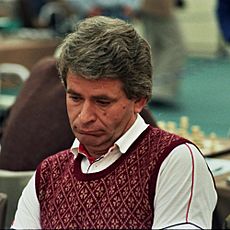
Polgár then tied for first in the Hastings tournament in 1992–93. She defeated Russian GM Evgeny Bareev in their second game. After Hastings, Polgár played an exhibition match against former World Champion, Boris Spassky. She won the match 5½–4½ and earned $110,000. Polgár also played in the Melody Amber tournament in Monaco. She finished fourth, ahead of strong grandmasters.
In 1993, Polgár became the first woman to qualify for an Interzonal tournament. She finished tied for second in the Budapest Zonal. She then won the tie-breaking tournament.
In the summer of 1993, Bobby Fischer stayed with the Polgár family. He was hiding from an arrest warrant in the United States. During his stay, he played many games of Fischer random chess and helped the sisters analyze their games.
In the summer of 1994, Polgár had a big success. She won the Madrid International in Spain. She finished 7–2, 1½ points ahead of second place. Her performance rating was 2778.
In October 1994, she played in a tournament in Buenos Aires. It was a tribute to Polugaevsky. Eight grandmasters played. The tournament was special because Black had to play a Sicilian Defence. This was Polgár's favorite opening. She finished tied for third.
In September 1995, Polgár finished third in the Donner Memorial in Amsterdam. She won her last game against Shirov in 21 moves. In November 1995, she played a friendly match against Jeroen Piket. Polgár won the match 6–2.
In 1995, a chess club in Scotland tried to arrange a game between Polgár and Nigel Short. They wanted to use the famous Lewis chessmen. These are chess pieces carved in the 12th century. The British Museum would not let them use the set. In the end, the Museum allowed the chess set to be displayed. Polgár won the tournament, winning both her games against Short.
Kasparov Incident
| a | b | c | d | e | f | g | h | ||
| 8 |

|
8 | |||||||
| 7 | 7 | ||||||||
| 6 | 6 | ||||||||
| 5 | 5 | ||||||||
| 4 | 4 | ||||||||
| 3 | 3 | ||||||||
| 2 | 2 | ||||||||
| 1 | 1 | ||||||||
| a | b | c | d | e | f | g | h | ||
| This example uses algebraic notation. |
At Linares 1994, Polgár lost a controversial game to World Champion Garry Kasparov. This was Polgár's first time playing with the world's strongest players. During her game with Kasparov, he reportedly changed his mind about a knight move. He moved the piece to a different square. According to chess rules, once a player lets go of a piece, the move must stand. Polgár did not challenge Kasparov at that moment. She said she did not want to cause trouble during her first big event. She also feared being penalized on the clock.
The incident was recorded on video. The video showed Kasparov's fingers had left the knight. The tournament director did not disqualify Kasparov. Polgár later confronted Kasparov. He then refused to speak to her for three years. Kasparov said his conscience was clear. Polgár called the game "one of the most remarkable moments of [her] career." This was the first time a female player beat the world's No. 1 player in a competitive game.
The Strongest Female Player Ever
Judit Polgár is generally seen as the strongest female chess player of all time. In January 1996, she became the only woman ever to be ranked in the top ten of all chess players. In August 1996, she played in a strong tournament in Vienna. She tied for fourth place. In December 1996, Polgár played a match against Brazil's champion Gilbert Milos. Polgár won two games, drew one, and lost one. She won $12,000.
In February 1997, she played in the Linares "supertournament." Polgár finished fifth among 12 grandmasters. Her result was considered excellent. In April 1997, she played in the Dos Hermanas Chess tournament. She finished sixth. In June 1997, she finished with an even score in the Madrid tournament. In July 1997, Polgár competed in the elite Dortmund International Tournament. She finished fifth. She won against Veselin Topalov, who was ranked fourth in the world. In October 1997, she tied for second in a tournament in the Netherlands.
"There is no argument about the greatest female player: she is 21-year-old Judit Polgár," wrote GM Robert Byrne in 1997.
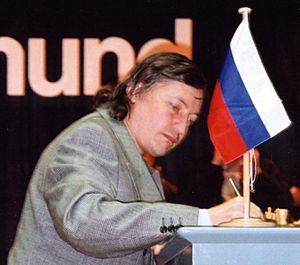
In January 1998, she played in the Hoogovens tournament in the Netherlands. She finished tied for sixth–tenth place. Polgár gave co-winner Viswanathan Anand his only loss. In June 1998 in Budapest, Polgár played an eight-game match of "action" chess against Anatoly Karpov. She won the match 5–3. At the time, Karpov was the FIDE World Champion. In August 1998, Polgár became the first woman to win the U.S. Open. She shared the victory with GM Boris Gulko. In October 1998, Polgár won the VAM tournament in the Netherlands. In November 1998, Polgár played in a Rapid chess tournament in Israel. She tied for first with Viswanathan Anand.
Polgár's rating had dropped since she first entered the top 10. This meant she was invited less often to the strongest tournaments.
In October 1999, Polgár shared first place in the VAM Chess tournament. In January 2000, Polgár had a disappointing result in Pamplona, Spain. She also had a disappointing result later in the month in the Corus Wijk aan Zee tournament. However, in the European Teams Championship in Georgia, she won the gold medal.
In April and May 2000, Polgár won one of the strongest tournaments ever held in Asia. This was the Japfa Classic in Indonesia. It included Alexander Khalifman, the FIDE world champion, and Anatoly Karpov. Polgár finished first, winning $20,000. At the end of May, she won a tournament in Sweden. In June 2000, she finished second in the GM Tournament Mérida. In September 2000, she shared first place in the Najdorf Chess Festival. In October and November, she played for Hungary in the 34th Chess Olympiad. Polgár scored 10/13, one of the highest scores.
In early 2001, Polgár played in the elite Linares tournament. She drew both her games with Kasparov. This was the first time she had done this. In March 2001, she reached the semifinals of the World Cup rapid play tournament. In June 2001, Polgár finished fourth in the European Championship. In October 2001, she tied for first in the Essent Tourney.
Making Chess History
In September 2002, in the Russia versus the Rest of the World Match, Polgár finally defeated Garry Kasparov. The game was played under rapid rules. She won with excellent positional play. Kasparov resigned when he was two pawns down. The game helped the World team win the match. Kasparov had once called Polgár a "circus puppet." Polgár called the game "one of the most remarkable moments of [her] career." This was a historic game. It was the first time a female player beat the world's No. 1 player in competitive play.
In October and November 2002, Polgár played for Hungary in the 35th Chess Olympiad. She helped Hungary win the silver medal. Hungary had the best win–loss record. Polgár's game against Azerbaijan's Shakhriyar Mamedyarov included a brilliant move.
By early 2003, Polgár was back in the top 10 rated players. In 2003, Polgár had one of her best results. She finished second without losing a game in the Category XIX Corus chess tournament. She was just half a point behind future world champion Viswanathan Anand. One highlight was her victory over Anatoly Karpov. She used a new move in the opening. The game lasted 33 moves. Polgár said she was "enjoying herself" by the end. In April 2003, Polgár finished second in The Hunguest Hotels Super Tournament. In June 2003, Polgár tied for third in a tournament in France. In August 2003, Polgár played an eight-game rapid chess match against Viswanathan Anand. Anand won the match. In October 2003, Polgár won the Essent tournament. In one game against Karpov, she used a famous double bishop sacrifice.
In 2004, Polgár took time off from chess to have her son, Olivér. She was not listed on the January 2005 FIDE rating list.
Polgár returned to chess at the Corus chess tournament on 15 January 2005. She scored 7/13 and tied for fourth. This brought her to her highest rating ever, 2735, in July 2005. She kept her spot as the eighth ranked player in the world.
In September 2005, Polgár made history again. She became the first woman to play in the final stages of a World Chess Championship. She qualified based on her rating. However, she finished last among the eight players.
She did not play at the 2006 Linares tournament because she was pregnant again. On 6 July 2006, she gave birth to a girl, Hanna.
Polgár played in the FIDE world blitz championship in September 2006. Blitz chess is played very fast. Polgár finished tied for fifth/sixth place. She won her game against Viswanathan Anand, who was world No. 2. In October 2006, Polgár tied for first place in the Essent Chess Tournament. She had two wins against the world's top-rated player, Veselin Topalov. In December 2006, Polgár played a six-game match of blindfold rapid chess against Veselin Topalov. Topalov won the match.
In May–June 2007, she played in the Candidates Tournament for the FIDE World Chess Championship 2007. She lost in the first round. Some experts said she was "poorly prepared." She had played less chess after having her two children. In July 2007, Polgár played in the Biel Chess Festival. She finished tied for third to sixth place. In October 2007, Polgár played in the Blindfold World Cup. She finished fourth. In November 2007, she played in a tournament to raise money for a hospital. Polgár finished tied for third.
In January 2008, she played in the Corus Wijk aan Zee tournament. She scored 6/13. In November 2008, Polgár had a difficult result in The World Chess Blitz Championship. She finished last. In November 2008, Polgár played for the Hungarian open team in the 38th Chess Olympiad.
In November 2009, Polgár played in the FIDE World Cup. She reached the third round before being eliminated.
Return to Competitive Chess
In 2010, Polgár started playing more competitive chess. In March 2010, Polgár played a four-game match against GM Gregory Kaidanov. The match was a draw. In April 2010, Polgár played an eight-game rapid chess match against Czech GM David Navara. Polgár won the match 6–2. Polgár played in a rapid chess tournament in Azerbaijan. She finished tied for fifth. In June 2010, it was reported Polgár was helping GM Zoltán Almási train for the Olympiad.
In September and October 2010, Polgár played for the Hungarian Men's team in the 39th Chess Olympiad. The team finished fourth. Polgár finished fourth overall among Board three players. In November 2010, Polgár won a rapid tournament in Mexico. She won a close match against Vassily Ivanchuk. She then defeated Veselin Topalov 3½–½ to win the tournament.
European Ch., Aix-les-Bains 2011
| a | b | c | d | e | f | g | h | ||
| 8 |

|
8 | |||||||
| 7 | 7 | ||||||||
| 6 | 6 | ||||||||
| 5 | 5 | ||||||||
| 4 | 4 | ||||||||
| 3 | 3 | ||||||||
| 2 | 2 | ||||||||
| 1 | 1 | ||||||||
| a | b | c | d | e | f | g | h | ||
| This example uses algebraic notation. |
On 2 April 2011, Polgár tied for first in the European Individual Chess Championship. She won the bronze medal. Polgár became the first woman to finish in the top three of the male championship. In July 2011, she played in the Greek Team National Championship. Also in July 2011, Polgár played for Hungary in the World Team Championships.
In September 2011, Polgár competed in the Chess World Cup 2011. She reached the final 8 players. A highlight was her win against the tournament's top player, Sergey Karjakin. In October 2011, Polgár took part in the Unive 2011 competition. She finished last in her group.
In September 2011, Polgár returned to "Super GM" status. Her FIDE rating was 2701. By November, it was 2710.
In January 2012, Polgár played in the Tradewise Gibraltar tournament. She finished with 7 points. For the first time in 22 years, Polgár lost a classical game to a female player. Women's World champion Hou Yifan won their game.
In 2013, Polgár received the FIDE Caïssa Award. This was for being the best female player of 2012.
On 5 October 2013, Polgár played Nigel Short in a Chess.com Death Match. Polgár won 17½-10½. She said it was "great fun."
In 2014, she competed in the World Rapid and Blitz Chess Championship. On 13 August 2014, she announced her retirement from top-level chess.
Judit Polgár's Playing Style
Judit Polgár is known for her aggressive playing style. She is excellent at tactics. She always tries to take the lead and create complex situations. Former world champion Garry Kasparov said that if "playing like a girl" meant anything in chess, it would mean "relentless aggression." When she was young, fans loved her wild attacks. Polgár prefers aggressive openings. She plays 1.e4 as White. With Black, she uses the Sicilian or King's Indian Defence.
Jennifer Shahade, a chess writer, suggested that Polgár's influence might be why women play more aggressive chess. Former U.S. Champion Joel Benjamin described playing against her. He said, "It was all-out war for five hours. I was totally exhausted. She is a tiger at the chessboard."
Polgár is especially good at faster chess games. Der Spiegel wrote that her "tactical thunderstorms during blitz games have confused many opponents."
Polgár also values the psychological side of chess. She likes to learn an opponent's style. Then she plays against that player's habits. In her 2002 win against Kasparov, she used a strategy he had used before. This made him "play against himself." Kasparov's moves were not good, and he soon lost. When asked about playing against computers, she said, "Chess is 30 to 40% psychology. You don't have this when you play a computer. I can't confuse it."
Life as a Chess Professional
"You have to be very selfish sometimes," Polgár said about being a professional chess player. "If you are in a tournament, you have to think of yourself." In 2002, she was asked if she still wanted to win the world championship. She said, "Chess is my profession... But I'm not going to give up everything to become world champion; I have my life."
Polgár said she did not have a permanent coach. She sometimes got help from GMs Lev Psakhis or Mihail Marin. She rarely used a second. When she traveled, her husband usually went with her. Polgár changed how she prepared for tournaments. She said she used her experience more and worked more efficiently.
Taking time off for her two children meant less time for training. Her ranking dropped from eighth in 2005 to the mid-50s in 2009. She played in the 2009 Maccabiah Games and was named the Outstanding Female Athlete. Polgár was the only woman in the top 100 until Hou Yifan reached rank 86 in August 2014. Polgár is still the only woman to have ever made the top 50. Comparing motherhood to chess, Polgár said a chess tournament now "feels like a vacation." She said she came back to chess because she "cannot live without chess!"
Despite being the highest-rated woman for 25 years, Polgár never competed for the women's world championship. She said she was never interested in it. But she noted that "the mentality of a couple of the women players has changed."
Polgár wrote a series of children's books about chess called Chess Playground. Her sister Sofia drew the pictures.
In March 2013, she received the Commander's Cross with Star of The Hungarian Order of Merit. This is one of Hungary's highest awards. It was for her achievements in chess and promoting the game. In August 2015, she received The Hungarian Order of Saint Stephen, Hungary's highest state award.
Personal Life
In August 2000, Polgár married Gusztáv Font, a Hungarian veterinary surgeon. They have two children: a son named Olivér (born 2004) and a daughter named Hanna (born 2006). While Judit stayed in Hungary, her sisters and parents moved away. Sofia moved to Israel, and Susan to the United States.
Several members of Polgár's family were killed in the Holocaust. Her grandmother survived Auschwitz concentration camp.
Notable Games
- J. Polgár vs. V. Anand, Dos Hermanas 1999 · Former trainer Tibor Károlyi called this the most beautiful game ever played by a woman.
- Judit Polgár vs. Ferenc Berkes, Hunguest Hotels Super Chess Tournament 2003 · Polgár's opponent fell for a clever trap.
- Alexey Shirov vs. Judit Polgar, Buenos Aires ARG 1994 · Polgár used a new idea to break up Shirov's pawns.
- Judit Polgár vs. Nigel Short, 1994 New York PCA/Intel-GP Rapid knockout tournament. Short seemed to have a winning attack. But Polgár recovered quickly and won.
- Polgár vs. Garry Kasparov, Russia vs. The Rest of the World match, Moscow 2002 · Polgár made history by defeating the world's No. 1 chess player.
The Judit Polgar Chess Foundation
The Judit Polgar Chess Foundation created two educational programs. One is Chess Palace for primary school children (grades 1–4). The other is Chess Playground for pre-school children. These programs aim to improve skills like problem-solving and strategic thinking using chess. Chess rules are used to teach general subjects like math and language. The program is very successful in Hungary. It is part of the Hungarian National Curriculum. In 2015, the Chess Palace book series won a special prize.
Books by Judit Polgár
- Judit Polgar: How I Beat Fischer's Record
- Judit Polgar: From GM to Top Ten
- Judit Polgar: A Game of Queens
Educational chess exercise books for pre-school children (in Hungarian):
- Kalandozások a sakktáblán (Adventures on the Chessboard)
- Sakklépések (Chess Moves)
- Sakk és matt (Check and Mate)
Educational chess books for elementary school children (in Hungarian):
- Sakkpalota (Chess Palace), series 1–4.
Awards and Recognition
- Hungarian Chess Player of the Year (many times between 1989 and 2014)
- 8-time Chess Oscar winner (for annual performance)
- Female Chess Player of the Century: 2001
- FIDE Caissa Award (the "Chess Oscar"): 2012
- The Knight's Cross of the Order of Merit of the Republic of Hungary (2003)
- The Commander's Cross with Star of the Hungarian Order of Merit (2013)
- Prima Primissima (2014)
- Member of the Association of Immortal Hungarian Athletes (2014)
- The Hungarian Order of St. Stephen (2015)
- Best European Learning Materials Award – for the Chess Palace Program (2015)
- Honorary Citizen of Budapest (2016)
- James Joyce Award from the UCD Literary & Historical Society (2017)
- ECU European Golden Pawn, "European Chess Legend" (2019)
- Honorary Doctor of the University of Physical Education (2020)
- Inducted into the World Chess Hall of Fame (2021)
- FIDE ICON Award (2022)
- FIDE100 Award, Best Player – Woman (2024), Best Female Chess Player of All Time
See also
 In Spanish: Judit Polgár para niños
In Spanish: Judit Polgár para niños
- List of Jewish chess players
Images for kids


